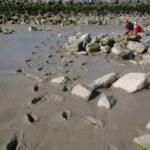 An overview on monitoring activities providing information on the presence of alien species among macrofauna, macro-algae and plankton in the Western Scheldt has been prepared by Ecoauthor, GiMaRIS and eCOAST. Almost a hundred alien species were observed during the last 25 years, for which vectors of introduction are indicated. The study gives a nice overview of the efficiency of techniques to detect certain alien species groups and the habitats where new alien species are most likely be encoutered. In the meanwhile new alien species have been detected in the Western Scheldt and are amongst others presented in the Transect Monitoring Report of 2017.
An overview on monitoring activities providing information on the presence of alien species among macrofauna, macro-algae and plankton in the Western Scheldt has been prepared by Ecoauthor, GiMaRIS and eCOAST. Almost a hundred alien species were observed during the last 25 years, for which vectors of introduction are indicated. The study gives a nice overview of the efficiency of techniques to detect certain alien species groups and the habitats where new alien species are most likely be encoutered. In the meanwhile new alien species have been detected in the Western Scheldt and are amongst others presented in the Transect Monitoring Report of 2017.
– Wijnhoven, S., Gittenberger, A., Faasse, M., Schellekens,T. (2017). Overview alien species monitoring in the Western Scheldt: Current status of monitoring efforts and presence of alien species among macrofauna and algae. Ecoauthor Report Series 2017 – 01, Heinkenszand, the Netherlands.
– Wijnhoven, S. (2017). Non-indigenous species presence and distribution in intertidal hard substrate environments of the Western Scheldt: Results of Transect Monitoring inventory of 2017 compared to 2015-2016. Ecoauthor Report Series 2017-04, Heinkenszand, the Netherlands.
– Wijnhoven, S. (2016). Non-indigenous species presence and distribution in intertidal hard substrate environments of the Western Scheldt: Results of Transect Monitoring inventory of 2016. Ecoauthor Report Series 2016 – 01, Heinkenszand, the Netherlands.
The overview report and the transect monitoring reports for the Western Scheldt are commissioned by the Office for Risk assessment and Research (BuRO) of the
Netherlands Food and Consumer Product Safety Authority (NVWA).

